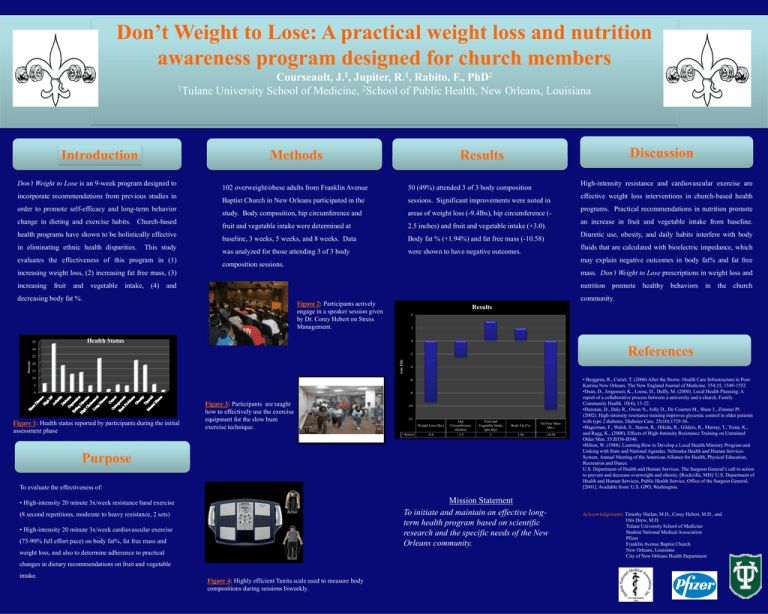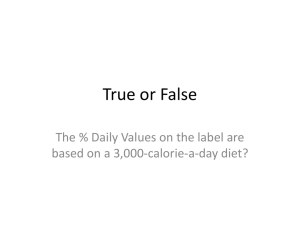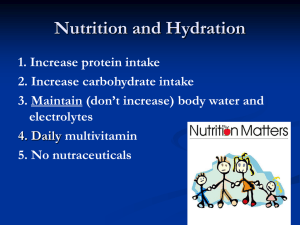PowerPoint Poster Template
advertisement

Don’t Weight to Lose: A practical weight loss and nutrition awareness program designed for church members Courseault, J.1, Jupiter, R.1, Rabito, F., PhD2 1Tulane University School of Medicine, 2School of Public Health, New Orleans, Louisiana Introduction Methods Don’t Weight to Lose is an 9-week program designed to incorporate recommendations from previous studies in order to promote self-efficacy and long-term behavior change in dieting and exercise habits. Church-based health programs have shown to be holistically effective in eliminating ethnic health disparities. This study evaluates the effectiveness of this program in (1) Discussion Results High-intensity resistance and cardiovascular exercise are 102 overweight/obese adults from Franklin Avenue 50 (49%) attended 3 of 3 body composition Baptist Church in New Orleans participated in the sessions. Significant improvements were noted in study. Body composition, hip circumference and areas of weight loss (-9.4lbs), hip circumference (- fruit and vegetable intake were determined at 2.5 inches) and fruit and vegetable intake (+3.0). baseline, 3 weeks, 5 weeks, and 8 weeks. Data Body fat % (+1.94%) and fat free mass (-10.58) was analyzed for those attending 3 of 3 body were shown to have negative outcomes. effective weight loss interventions in church-based health programs. Practical recommendations in nutrition promote an increase in fruit and vegetable intake from baseline. Diuretic use, obesity, and daily habits interfere with body fluids that are calculated with bioelectric impedance, which may explain negative outcomes in body fat% and fat free composition sessions. increasing weight loss, (2) increasing fat free mass, (3) mass. Don’t Weight to Lose prescriptions in weight loss and increasing fruit and vegetable intake, (4) nutrition promote healthy behaviors in the church and decreasing body fat %. 35 community. Figure 2: Participants actively engage in a speaker session given by Dr. Corey Hebert on Stress Management. Results 4 2 Health Status 0 References 30 -2 Axis Title Percent 25 20 15 10 -4 -6 5 0 -8 Figure 1: Health status reported by participants during the initial assessment phase Figure 3: Participants are taught how to effectively use the exercise equipment for the slow burn exercise technique. -10 -12 Weight Loss (lbs.) Series1 -9.4 Hip Circumference (Inches) -2.5 Fruit and Vegetable Intake (per day) 3 Body Fat (%) Fat Free Mass (lbs.) 1.94 -10.58 Purpose To evaluate the effectiveness of: Mission Statement To initiate and maintain an effective longterm health program based on scientific research and the specific needs of the New Orleans community. • High-intensity 20 minute 3x/week resistance band exercise (8 second repetitions, moderate to heavy resistance, 2 sets) • High-intensity 20 minute 3x/week cardiovascular exercise (75-90% full effort pace) on body fat%, fat free mass and weight loss, and also to determine adherence to practical changes in dietary recommendations on fruit and vegetable intake. Figure 4: Highly efficient Tanita scale used to measure body compositions during sessions biweekly. • Berggren, R., Curiel, T. (2006) After the Storm- Health Care Infrastructure in PostKatrina New Orleans. The New England Journal of Medicine. 354;15, 1549-1552 •Dean, D., Jorgensen, K., Loose, D., Duffy, M. (2000). Local Health Planning: A report of a collaborative process between a university and a church. Family Community Health. 10(4); 13-22. •Dunstan, D., Daly R., Owen N., Jolly D., De Courten M., Shaw J., Zimmet Pl (2002). High-intensity resistance training improves glycemic control in older patients with type 2 diabetes. Diabetes Care. 25(10):1729-36. •Hagerman, F., Walsh, S., Staron, R., Hikida, R., Gilders, R., Murray, T., Toma, K., and Ragg, K., (2000). Effects of High-Intensity Resistance Training on Untrained Older Men. 55:B336-B346. •Hilton, W. (1988). Learning How to Develop a Local Health Ministry Program and Linking with State and National Agendas. Nebraska Health and Human Services System. Annual Meeting of the American Alliance for Health, Physical Education, Recreation and Dance. U.S. Department of Health and Human Services. The Surgeon General’s call to action to prevent and decrease overweight and obesity. [Rockville, MD]: U.S. Department of Health and Human Services, Public Health Service, Office of the Surgeon General; [2001]. Available from: U.S. GPO, Washington. Acknowledgements: Timothy Harlan, M.D., Corey Hebert, M.D., and Otis Drew, M.D. Tulane University School of Medicine Student National Medical Association Pfizer Franklin Avenue Baptist Church New Orleans, Louisiana City of New Orleans Health Department











